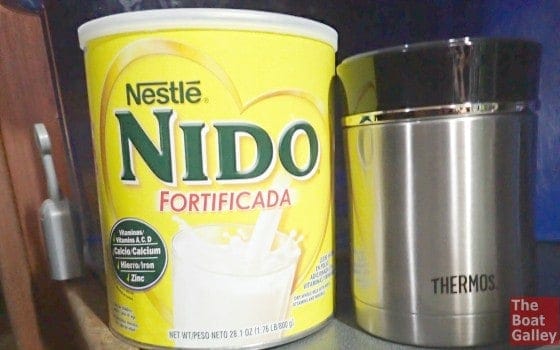Store-bought yogurt is hard to carry on a cruising boat. It has to be refrigerated to store it more than a day, which takes up valuable refrigerator space. In some places, it’s also hard to find. Luckily, it’s easy to make your own, the ingredients can be found almost everywhere, and the results are even better than store-bought.
The basic recipe for yogurt is very easy—warm milk and a little yogurt from the last batch, kept in a warm place while the culture grows. As with many things, the devil is in the details, and attention to detail is crucial to successful yogurt-making. A good Thermos and thermometer are essential, as are the right ingredients.
Thermos. You don’t have to have a fancy yogurt maker, but you do need a Thermos to keep the mixture warm while the culture grows. The mix has to stay warm for 6 hours or longer, and so a really good Thermos is essential if you’re in a cool climate. Read my full article on the best Thermos bottles. Most cruisers find that a pint (2 cups/16 oz./500 ml) to quart (4 cups/32 oz./1 liter) size works well—here’s the one I use.
Thermometer. A thermometer is essential. Guessing at the right temperature of the milk just doesn’t work—a few degrees too hot and the culture will be killed; too cool and it won’t grow. You need one that can read between 110 and 120 F.—see my recommendation on a good inexpensive instant-read thermometer.
Powdered Milk. Using powdered milk produces excellent results and is much lighter and less bulky than carrying regular milk (not to mention that you don’t have to refrigerate it). Don’t worry—most powdered milk is better than the Carnation non-fat stuff that many of us are familiar with (don’t even try to use that).
- For your initial efforts, don’t use a low-fat or non-fat milk. It is much harder to obtain satisfactory results. Once you have the technique down, you can gradually transition from full-fat milk to non-fat.
- Do not use a brand with “added vegetable fat.” These are widely available in Latin American countries, but the culture will not grow.
- The higher the fat content in the milk, the creamier the end result will be—and the more calorie-laden.
Read more about buying great powdered milk.

Yogurt Starter. You need yogurt with a live culture as starter. Your best bet is to get some from a cruiser who makes his or her own. In some places, you may be able to buy “home-made” yogurt. If you have to buy commercial yogurt, there are several points to remember:
- It must contain LIVE culture.
- It must NOT contain gelatin.
- The fewer additives, such as flavors, the better.
In many Latin American countries, I’ve found that the yogurt drinks work best, especially ones promoted as digestion aids. Because they have a thinner consistency, use at least twice as much of a drink for starter as you would a thick yogurt.
In the US, you can buy special “yogurt starter cultures” in health food stores and online. While these are great if you want to be able to periodically have yogurt and not keep it going all the time, they are more expensive and are not needed.
Water. The only real problem with water is that the stuff we put in the water tanks to kill bacteria (bleach, etc.) will also kill the yogurt culture. If you have a drinking water filter, the filtered water works well. If your water has a chlorine smell or taste to it, the best thing to do is to heat it close to a boil to quickly dissipate the chlorine before using it in yogurt. If you use bottled water for drinking, it is generally fine.

Basic Yogurt Recipe
Ingredients
- 1-1/4 cup powdered milk -- the powder, not milk made from the powder Use good quality powdered milk, see notes.
- 1/2 cup water. Avoid chlorine in water, see notes.
- 1-4 tbsp starter yogurt. Must have live culture and no gelatin.
Instructions
- Heat 3 cups of water to almost boiling (if it does boil, no problem). Pour it into the Thermos and put the stopper on. Let sit for a couple of minutes to pre-heat the Thermos.
- Pour the hot water out of the Thermos and reserve in a container. Return about 1/2 cup of the hot water to the Thermos.
- Add the milk powder and mix. Put a candy thermometer into the Thermos or use your instant-read thermometer after every addition of water. Alternately add hot water and regular-temperature water, mixing after each addition, so that Thermos is almost full (about an inch below where the stopper will come) and temperature is between 110 and 120 Farenheit.
- If temperature is higher, let mixture sit until temperature has dropped into the correct range. If temperature is lower, remove some of the mixture and heat it, then return it to the Thermos and check temperature again. If temperature is too low or too high, the yogurt will not culture.
- Once the temperature is correct, add 1 to 2 tablespoons of starter yogurt or 2 to 4 tablespoons of yogurt drink and stir it in. The mix should come almost exactly to where the bottom of the stopper will come. Put the stopper back on the Thermos and put in a place where it can sit undisturbed for 4 to 5 hours.
- After about 4 hours, remove the stopper and look inside. If yogurt does not appear thick, replace stopper quickly so as not to lose the heat and check again in 1 to 2 hours.
Notes

Carolyn Shearlock has lived aboard full-time for 17 years, splitting her time between a Tayana 37 monohull and a Gemini 105 catamaran. She’s cruised over 14,000 miles, from Pacific Mexico and Central America to Florida and the Bahamas, gaining firsthand experience with the joys and challenges of life on the water.
Through The Boat Galley, Carolyn has helped thousands of people explore, prepare for, and enjoy life afloat. She shares her expertise as an instructor at Cruisers University, in leading boating publications, and through her bestselling book, The Boat Galley Cookbook. She is passionate about helping others embark on their liveaboard journey—making life on the water simpler, safer, and more enjoyable.
Simplify meal prep on board with proven strategies for provisioning, maximizing fridge space, and cooking delicious meals aboard your boat.










Danielle says
Ha, you read my mind! I was going to ask you if making yogurt on a boat was possible. Thanks for the tips!
marie ralph says
Thankyou so much for your great website.
I have successfully made my own yogurt and last night we enjoyed pear muffins (made with yoghurt not butter) and served with honeyed yoghurt. YUMMY!!!!!
There is so much on this site that is going to be indispensible in my new life as a liveaboard woman.
I have been experimenting with dehydrated egg, I used it in the muffins, and I am very pleased with the results. This may be worth an article?
Again thankyou for a great site, and looking forward to your cookbook
Carolyn Shearlock says
Glad to hear that the yogurt was a success — and the muffins sound wonderful.
I’ve used dehydrated eggs some in the past — I’ll add them to the list of “article ideas”!
Thanks, Carolyn
Idarae says
What do you know about dry ice & its best usage?
Carolyn Shearlock says
Hi!
I have to be honest, I don’t know much about dry ice except for some long-ago high school chemistry experiments. Actually, I don’t even know where you’d get it. Is it available where you are?
-C
Ken Arnold says
Put it in a cooler and only outside, on deck.
CO2 drops low, it doesn’t go up like most Gasses, it displaces Oxygen and you can suffocate in a Cabin.
Sarah says
Hi! I’ve been researching many different yogurt recipes, and they all say that the yogurt needs to be VERY undisturbed. Even the most gentle anchorage has movement, though. What is your answer for this? I was thinking of just gimbaling the stove and letting it set in there over night (better temperature regulation, too), but that doesn’t address any fore and aft movement. What has been your experience with this?
Thanks,
Sarah
Carolyn Shearlock says
Hi Sarah —
I’ve made yogurt even underway, although never in really rough conditions. Just put it low and near the center of the boat and it’ll be fine. I had worried about this at first, but I’ve found it not to really be a problem — I’ve even moved the thermos around during the course of the day, opened it up to check on it, etc. I mean that you want to do what you can to keep it undisturbed (don’t play catch with the Thermos ) but don’t worry excessively.
The first batch or two are the hardest to get cultured in my experience. Just use plenty of starter (it won’t hurt at all to use extra) and you may have to let it sit way longer than you will when you get it more “established” — I thought mine wasn’t culturing the first few times, then accidentally left a batch for about 12 hours and found it had done its thing!
Charles says
It should be noted that yogurt is not required to be made from animal milk. Quite good yogurt can be made (exactly the same process, temperatures and timing) with soy, rice or almond milk; pretty much any horchata, for that matter. If you are lactose intolerant, you can still enjoy yogurt.
Carolyn Shearlock says
I’ve never had any luck trying to make yogurt from anything other than milk; it’s my understanding that you need the lactose in milk for it to culture. I’d love to hear more about how you do it, as my husband has developed an allergy to milk and misses his yogurt.
In fact, it’s the fact that yogurt uses up the lactose that makes it so that most lactose intolerant people can eat regular yogurt without a problem.
Carolyn
Adrienne says
My understanding is the culture converts the milk sugars (lactose) to lactic acid and that is why they can tolerate it. Lactic acid is easier to digest.
I make my yogurt from non-fat milk powder using the commercial powder packet yogurt for the culture. I use a few tablespoons of the yogurt powder. I’m talking about the packets of yogurt powder that make up a litre. But I get up to 4 litres doing it my way with one packet. Frugal and travel friendly. It took me some experimenting but it works. I will try it using your milk powder/water measurements.. They key was keeping the heat up to it.
Candy Ann Williams on Facebook says
Carolyn, I am going to try and make some AFTER I get a new GOOD thermos …when you mentioned that homemade was thicker is it as thick as the Greek style? If you start with a good Greek with live cultures will you end up with the Greek yogurt? I have recently started eating the greek and now i am spoiled and like it much better than the traditional i used to eat Thanks….
Christine Lubimir says
I strain it to get Greek yogurt. You will end up with a lot less but the consistency you are looking for. I have saved the whey that strains out in pancakes.
nichola wright says
Hi – great article. How long does the home made yogurt keep for if refridgerated?
are you having to make a new batch every few days to make sure your saved starter doesn’t go off?
Thanks, Nichola
Carolyn Shearlock says
I’ve kept it as long as week — actually my problem is usually making it as fast as we eat it! It didn’t seem to be going bad at all at a week, so I’m not sure what the actual limit might be.
Mike says
Hi Carolyn,
I have been a reader for awhile, totally enjoy your articles. Will an icebox work for refrigeration? Sometimes I run a little low on the ice, how temperamental is the starter?
Thanks,
mike
Carolyn Shearlock says
Yogurt was developed by nomadic people literally thousands of years ago . . . long before refrigeration! It will just keep getting more and more tart if you don’t refrigerate it, until finally — after several days, depending on the climate — it will mold. It won’t go sour the way milk will.
With an icebox, no problem! I’ve kept it in a cooler many times when camping. As long as it hasn’t turned green, it’s fine to use.
The Boat Galley on Facebook says
Even without starting with Greek, it’s much more like the Greek — or is after you’ve made several batches. Starting with Greek works really well . . . and I’ve found that the first several batches just get better and better. The first batch is often thin and takes longer than expected to culture, then it gets better with each subsequent batch. So don’t get discouraged if the first batch isn’t “perfect.”
The Boat Galley on Facebook says
To get Greek, use plenty of good powdered milk (you can use a little more than the recipe calls for, but don’t use tons more), and use plenty of starter (you can easily double the amount). The biggest problem I have — with any starter — is getting the first batch to culture. Greek yogurt with no additives words really well!
Candy Ann Williams on Facebook says
Thanks so much Carolyn. As soon as I get my new thermos I am going to try it. I am still in the states…can you recommend a ‘good’ powdered milk? Thanks again for your help. Have a great Sunday….hope your foot/ankle is getting better. 🙂
The Boat Galley on Facebook says
Absolutely! Get Nido in the Mexican foods aisle, instead of the stuff in the baking aisle. See https://theboatgalley.com/great-powdered-milk/ for pictures of the good stuff and more info!
Candy Ann Williams on Facebook says
Thanks again Carolyn. I’ll let you know how it turns out once I get my new thermos (I will use your thermos guide before I buy). I can’t wait to make some. 🙂
Ray Johnson on Facebook says
Have you seen the price of powdered milk lately?
The Boat Galley on Facebook says
It always seems high to me — then I look at the price of regular milk, boxed milk, and various milk products and it tends to fall in line. I think since it’s “concentrated” the price increases are really noticable — while a gallon of milk goes up a dime at a time, a container of powdered milk that makes 10 gallons goes up a dollar.
Ray Johnson on Facebook says
No doubt your correct…it’s been awhile since I purchased it, but it was a bit of a shock when it rang up. My wife loves yogurt, she can try this since we now have an ample supply 😉 Thanks!
The Boat Galley on Facebook says
Enjoy!
Anna says
Thanks for this article. I make yogurt often now, and was unsure how I’d manage it once we move to a boat. The method I use is stovetop so it seemed unrealistic. Thanks so much, losing out on regular yogurt would have resulted in a mutiny from my kids.
Carolyn Shearlock says
Doing it in a Thermos is one of the best things I learned while cruising . . . and now I use the same technique off the boat!
Anne-Marie says
Thanks for creating a great cookbook! We are cruising Mexico on our Islander 36 and I love your recipes. I just made our first batch of boat yogurt and it’s delicious! I’m definitely hooked. Do you have a recipe for making yogurt from milk (in liquid form)? It would be handy when we’re near land and liquid milk is cheaper than the powered. Thanks in advance!
Carolyn Shearlock says
A friend has told me that you can use milk and half the amount of powdered milk — she likes to add the powdered to make the yogurt fairly thick (like Greek yogurt). But don’t try to use “boxed milk” — it’s been ultrapasteurized and won’t ferment correctly. Note that I haven’t actually tried using regular milk, I’m just going on what a friend used (but she made yogurt fairly regularly, so I trust the info).
Let me know how it goes! – Carolyn
Richard Bernstein says
Has anyone tried “probiotic” tablets, available in pharmacies and health food stores for yogurt starters? These are mostly live acidophilus bacteria, I think.
Carolyn Shearlock says
I’ve tried them with a couple different brands and very poor results on the yogurt-making. By that, I mean that after 12 hours the milk was slightly thicker, but not even the thickness of a typical yogurt drink and definitely nowhere near yogurt consistency. I’ve read a few articles online about using them as the starter, but I’m guessing that the “writer” (maybe a copier? the wording is almost identical) never actually tried doing it, just heard a rumor that you could. For some reason, those articles never have photos . . .
Sailing with Totem on Facebook says
we love making yogurt aboard!
James says
Carolyn, Can the yogurt made with this process be used in a self serve frozen yogurt machine after adding some flavors?
Carolyn Shearlock says
Well, I’ve never tried that . . . never had access to one. But if you can use Greek yogurt in one (and you might need to check the owner’s manual for that) this is very similar so I’d think you could. But if Greek yogurt is too thick, it might be a problem.
vrkelley says
Oh thank you Carolyn! I use a slightly different recipe that uses fresh milk, thermos and thermometer. However, a coffee decanter on board (the inside looks like a mirror) works just as well. You don’t even have to fill it up…Just pre-heat the decanter and toss it in there.
Sarah Bell says
Hi, was having another look at your great website and thought I would let you know about Easiyo. You may already be aware of this and are unable to sell on? Here is a link to Rod Heikell’s old website with the technique
freewebs.com/seawrite/gourmetsandgourmands.htm#179458179(Update: site no longer available)You do have to buy the kit initially and it comes with a few starter packs which gives you confidence the first few times but I haven’t used them ever since, starting the culture off with any plain (Greek if I can get it) I’ve yoghurt. But it doesn’t require heating up to exact temperatures as you rely on the external boiled water, which makes it easier underway. They also give you a booklet for hints, such as using very cold water from the fridge (I’ve used it for the final top up) or reducing the level of the hot water in the thermoset by 1cm makes all the difference I f the boat is REALLY hot (eg Middle East….!).
Hope I am not teaching my grandmother to suck eggs!
Many thanks for all our info
Best wishes Sarah
Jackie Parry says
Great – detailed recipe. I have been making yoghurt for years with just a saucepan, 3 tablespoons of yoghurt, milk and a towel. I heat the milk (about 1 litre) to what feels like a “warm day” – stir in (gently) the three tablespoons of yoghurt. Wrap the pot up in a towel and stow (normally in the gimballed oven, especially if underway-over night (or for at least 6 hours)). That’s it. It does work better with powdered milk and I admit I have got it down to a fine art now. I am currently between boats and do this all the time at home still. I have detailed this in our book Cruisers’ AA (which contains over 1,800 tips tricks and ideas on living on board – but it is the only recipe! I am no cook – that’s why I come to this brilliant website!
Deborah says
Thanks for your great ideas…
In battling cancer, we have removed diary and soy from our diet. Would coconut, rice, or almond milk work? Any suggestion for a powdered probiotic ? Would that work ok?
Thank you
Deborah
Carolyn Shearlock says
Unfortunately, you have to use “real” milk because it’s the lactose that feeds the starter and cultures. Other types of “milk” don’t have the lactose and therefore won’t turn into yogurt. We have the same problem as my husband has developed a milk allergy (not just lactose intolerance but a true anaphylactic allergy) and now can’t have yogurt.
Toni Borrett says
Going to give this a go now we are living aboard. I read somewhere that after about 5 reuses you should get a new starter? If it thickens though does that mean it’s still live? Your thoughts?
Carolyn Shearlock says
I’ve used a bit from the previous batch for over a year, going from batch to batch, so no, I don’t think you need to get new starter. The only reason I’ve gotten new was that we took a trip back to the US and so had to get rid of everything in the fridge. As long as it works, no need to get new (I wonder if this piece of advice wasn’t created by the starter companies to keep people buying more . . .). Enjoy!
Martin Henry says
Angela McCarthy Henry
Sherlene Eicher says
Have you tried to make cheese from this Milk?
The Boat Galley says
I haven’t, but some friends have done it and say it was good!
Sherlene Eicher says
Hmmm… I’ll try it.
Jan Bogart says
I never had luck with that.
Joy Harrison Canova says
Your recipe is for a 3 cup, the thermos is 2 cup. Any special advice on scaling down the recipe?
The Boat Galley says
Nope, same temp, just less ingredients. Same time frame. My other one was 3 cups, but when I had to get a new one I got a smaller one since Dave has developed an allergy to dairy and I’m the only one eating it.
Joy Harrison Canova says
Thanks!
Jo Anne Peyton says
You use less milk, the culture isn’t particular
Jim Allen says
Have you tried it with your thermal cooker yet?
The Boat Galley says
I don’t want to make that much at once! I make 2 cups at a time in my small thermos. I’m sure the thermal cooker would do well for a big batch — but it’d have to be close to a gallon to fill it full enough. 🙂
Paul Smith says
Yoghurt.
Boni Rothmann says
I have since the 70’s!
Boni Rothmann says
I will be sharing my outdoor simple and heathy recipes with you soon, you will be happy!
Sarah Larson says
Just thought I’d mention the whey can be used to ferment fresh vegetables for long term storage. Here is a recipe for carrots & Ginger condiment. You can do all kinds of vegetables this way.
Ginger Carrots
Yield:1 quart
Ingredients:
4 cups grated carrots, tightly packed (grate these fresh, from REAL carrots, not the little carved ‘baby’ ones)
2 teaspoons freshly grated ginger
2 teaspoons sea salt (not iodized)
4 T Whey
Preparation:
In a bowl, mix all ingredients and pound with a wooden pounder or squeeze and rub between your hands to release juices. Place in a quart-sized, wide mouth mason jar and press down firmly with a pounder or your fist until juices cover the carrots and there are no air pockets. The top of the carrots should be at least 1 inch below the top of the jar. Cover tightly and leave at room temperature for about 3 days. You will see it bubbling when it’s ready.
sv Juniper says
Thanks so much for this. I’ve been making yogurt for a while now with whole fresh milk just fine however, now that we’re in Mexico and on the move, whole fresh milk is less reliable. I tried using the traditional yogurt-making procedure using powdered milk without success (super watery). Tried it your way three times now and the results are perfect! I was just about to give up on homemade yogurt. Thank you!
Carolyn Shearlock says
Great to hear! Thanks for letting me know.
SARAH H LARSON says
Cultures for Health website offers vegan yogurt cultures. https://www.culturesforhealth.com/
Dave Skolnick (S/V Auspicious) says
I make yogurt in larger batches and find the Thermos inconvenient. My approach is based on what I learned from honest to goodness Tibetan Buddhists in the train of a Rinpoche. The adjustments are that I use cow milk instead of yak milk and don’t culture under the saddle blanket of a yak.
Generally I make either a quart or a half gallon starting with UHT (boxed) milk. I heat the milk to 180°F and let cool in the pan to below 120°F. Add the yogurt culture (last batch) and let stand ten to twelve hours. “Let stand” should keep it between 110°F and 120°F just as Carolyn says to facilitate culture growth. If the engine has run recently tucked into a clean corner of the engine room or on top of the water heater works well. In the tropics out in the sun on a dark surface works okay. I transfer to Ball jars, the same we use for canning, with a canning funnel. The yogurt should last about two weeks in the fridge. Half a gallon usually only lasts me four days. *grin*
Carolien says
Hi! Thank you so much for your great advice and extended recipes and notes 🙂 I ordered a Thermos and a thermometer according to your advice.. and now it’s almost time to start going!
I am just wondering 1 thing: how long can I save the batch? Maybe you don’t know it as you used it over a year and probably every day, but for example: can i make the yogurt two days in a row from batch to batch and then save the newest batch for longer than that?? Or do you have to keep going?
Best wishes and thank you so much for your great blog!!
Carolien
Carolyn Shearlock says
You can save it about a week in the refrigerator.
Jeff says
Couple of questions: are you supposed to add more powder than the milk instructions call for? Your recipe calls for 1 1/4 cups of powder to make 3 cups of milk. The Alpura milk we get in Mexico calls for 1/2 cup of powder to make a liter of milk. Also, seems like it would be easier to make the milk in a pot and heat it to the right temperature directly, pour in thermos and add the starter. Rather than trying to manage the temperature in the thermos?
Carolyn Shearlock says
I find that making the “milk” thicker makes for a creamier, thicker yogurt. You may prefer it less thick. You certainly can make the milk in a pot and then heat it. I find it faster to adjust the temp in the thermos — I’d almost always get it too hot in the pan and then have to wait for it to cool down. It’s up to you!